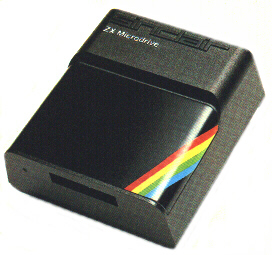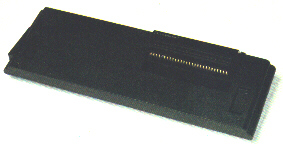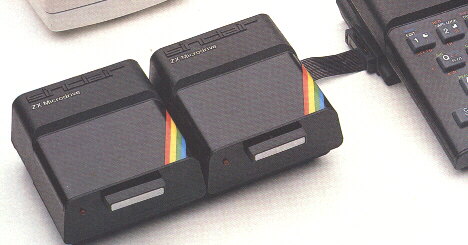Sinclair Interface I + Microdrive


The following article was taken from Sinclair User - October 1983
The Microdrive with the Interface 1 module has
produced the biggest improvement to the Spectrum yet. It can do eveything a disk drive can
do but is much cheaper and the interface contains three modules for the price of one. The
interface unit controls the Microdrive and RS232 communications/printer interface and a
network which allows you to talk to another 63 Spectrum users. The unit fits underneath
the Spectrum and tilts it a comfortable typing angle of 20 degrees. It is fixed in place
with two screws to stop any 'wobble' that might occur. On the back of the unit are 3
sockets and a duplicate of the expansion connector, so other devices can be plugged in.
The RS232 interface is a standard way of connecting printers and other devices like modems
which use only one wire to pass data across. Each byte is broken into eight binary bits -
see the BIN function in the Spectrum manual - and sent down one bit at a time. That method
of swapping information is called serial access and is used on all the Interface 1
devices, including the Microdrive. That involves timing the length of each bit and so the
speed of the RS232 can be set to match the speed of the device from which you are
sending or receiving data. Speeds of up to 19,200 bits per second - the baud rate - can be
set easily by POKEing a number into two new system variables listed in a new manual
provided. Those system variables take up another 58 bytes after the ones listed in the
original manual. Sinclair has made Basic the operating system of all the devices connected
to the interface, so you will have to learn to use the channels and streams information
contained in the new manual along with the various extensions to Basic provided by the new
ROM.
Apart from streams, the extra commands are MOVE,
ERASE, FORMAT and CAT. MOVE transfers a file of information - not a program - from one
device to another. CAT provides an alphabetical list of files on a Microdrive showing
their names and the amount of free space in Kilobytes. Files can be protected from CAT by
including CHR$(0) as the first letter in the name. As with cassette files there is no
foolproof way of protecting anything on a computer. ERASE allows you to clear out the file
named on the Microdrive and FORMAT allows you to wipe a Microdrive cartridge.
The Microdrive is a very simple device. It has only two moving parts - three if you
include the write-protect switch. The motor and a ratchet which stops the motor reversing
are the only moving parts. The tape head is fixed and two springs either side, which bring
the tape to the head and not the other way round, eliminate the need for alignment of the
head. It acts like a very fast continuous loop tape recorder running past the head at 30
inches per second - 16 times as fast as a normal cassette recorder.
The tape is made of 1.9mm wide, 23 micron thick video tape, which is slightly
thicker than domestic home video tape. Sinclair claims that more than 5,000 operations can
be done on the tape before it wears out. The tape format is in blocks of 512k bytes called
sectors and if a block is faulty it is marked so that it is not used. All cartridges have
at least 85k of space but the amount varies depending on the number of sectors damaged by
the manufacturing process. With up to eight Microdrives connected to one Spectrum, 860k of
storage can be acheived. Cartridges are available at £4.95 each.

The following review was taken from Your Computer 1983
Sixteen months after they were announced the
first Microdrives are jut being delivered, The price is still £50 for a drive which takes
85K tape cartridges instead of the l00K originally promised, but you can find and load a
program in a few seconds. You will also need the Interface 1 before you can plug in up to
eight Microdrives, but this interface gives you RS-232 and local area networks.
The Microdrive is housed in a box 90 by 85 by 40mm in size with an aperture at the
front for loading the cartridge, and printed circuit board edge connections on both sides
towards the rear. The right hand connector plugs via a flexible cable to the interface
unit, if it is Microdrive 1 or plugs directly through a double ended socket to the next
Microdrive. The drives are secured to each other by a plate underneath the housings. This
should prevent the dreaded wobbles.
There are two small printed circuit boards inside which are without modification.
The lower board provides the two edge connections, while the central vertical board houses
a ROM and the tape head, which is used for both record and erase functions.
The mechanism is uncomplicated- The drive is generated by a rubber roller mounted
directly on the end of the motor spindle. Pressure is applied by a leaf spring on the
opposite side of the cartridge. The spring also maintains the cartridge position relative
to the head, a very simple and highly efficient setup. My only worry would be head wear
due to the abrasive action of the tape.
When the Microdrive is running, an LED indicator is lit. A warning is given not to
remove the cartridge while this light is on
The cartridge is claimed to be able to handle up
to 50 files and have a minimum storage capacity of 85K. The two spare cartridges supplied
for the review both had 90K of storage space available when formatted,
Typical access was very fast in comparison with cassettes but, human nature being what it
is, you tend to notice when it is slower than usual, It can take longer to type in the
load command than to find and load a short file The storage media is an endless loop of
tape. The cartridge is very small 45 by 35 by 7mm., including cover and makes the
opposition's 75mm. floppies seem huge in comparison. The cartridge can he write-protected
in a
similar manner to cassettes by removing a plastic tab, a piece of sticky tape with
re-enable write.
I assume that before long we will be able to purchase S100 and S200's - Sinclair 200K
-cartridges, In some
applications it is quantity of storage rather than speed of access that is important. It
will also be necessary to
store the cartridges in a holder similar to those available for cassettes. The Sinclair
hardware add-on industry
is in business again.
Sinclair only supplies one blank cartridge per Microdrive, further cartridges are supplied
singly with an order form for repeat purchases. Bearing in mind Sinclair's advice on the
need for back up copies, it just is not sufficient.
It is possible to use strings for filenames in the Microdrive commands and variables for
the Microdrive number.
Because of the initial high cost of the cartridges, it makes sense to produce the tidy
facility shown in Program 1.
Program 2 was used to test the file storage
capacity of 50 files. Three points emerged from the tests:
1) Each file appears to occupy a minimum block of 512 bytes.
2) As the limit of 50 files is exceeded, file names disappear from the catalogue in an
apparently random fashion,
but they still occupy space on the cartridge and are still loadable.
3) The average time taken to Save a short file in this manner is 10 seconds.
An attached Microdrive has no effect on the vast majority of commercial software. Only in
one case where a
program used interrupt control was a program found not to work, and I am not sure why not.
If you open a stream to the Microdrive or Net then problems will arise, but if you do not
try to use the Microdrive or try to Network a program then it should make no difference
whatsoever. The user is warned not to remove a cartridge while the Microdrive's LED is lit
and not to switch on or off with a cartridge in the drive. This I continually forgot with
no apparent mishaps to the stored data.
I think the user would be wise not to leave a cartridge in the drive for long periods of
storage, the pressure roller
may take a permanent set and upset the tape transport. I would have liked a protective
flap over the cartridge
entrance, not all drives will be used in a clean environment.
The ZX Interface 1 was also announced in April
1982. It was simply called the RS 232/Network interface board
and was expected to sell for £20. Since then it has been expanded and now serves three
functions:
>Microdrive controller
>RS232 interface
>Local-area network
This little box of goodies is something special. There are flaws but it is still a very
powerful addition to the Sinclair range of computer peripherals.
Surprisingly the two printed circuit boards in the Microdrive show no signs of
modification whereas the printed
circuit board in the interface has been altered. The board contains two integrated
circuits, a prototype Ferranti
LSI and an EPROM.
A Sinclair spokesperson has stated that the equipment delivered to customers will, in
fact, contain proper
production devices.
The interface plugs into the Spectrum rear connector and is attached through two existing
screw holes to the
underside of the Spectrum, the original screws may be discarded. A duplicate rear
connector port is available
on the interface as are the two 3.5mm, network sockets and the nine-pin d-shell connector
for the RS-232
printer/peripheral interface.
The Microdrive plugs into the exposed printed circuit board edge connector at the side
through a flexible cable.
The whole assembly is rigid and now the keyboard has been tilted, feels much easier to
use.
The interface unit acting as the Microdrive
controller, expands Sinclair Basic to include elementary file handling
and communications commands.
The commands are created by paging the 'new’ RQM which creates an additional set of
system variables. It
looks from an cursory glance, that it is possible to re-vector the input - output routines
used in both the
Microdrive and Network channels.
The commands become a bit of a chore to handle after a while and you are soon driven to
looking at
producing your own simple operating systems.
The RS232 interface, which operates over a range of 5O to 19.2K baud with no parity, 8-bit
character and two
stop bits, should cover just about all but split-speed operation There are two modes of
operation.
The t channel is normally used for listings, the control codes are not sent except for 13
-carriage return - and
the token codes are expanded. There is no graphic capability. These characters are
replaced by code 63 (?).
The b channel sends the full 8 bit code and is used to send control codes to printers etc.
I can not recall ever having said that something from Sinclair was expensive, but £15 for
an interface lead is a
bit steep.
The ZX Net - local area network -promises to be a very powerful tool. The network is set
up by simply joining
two Spectrum interfaces together with the 10ft. long net lead. The manual reveals a
network operating at l00K
baud with handshaking between two attached devices. Up to 64 Spectrums can go on the net.
Print station facility
There is also a broadcast facility to download information to anybody listening on the
net. This would permit a
teacher to broadcast a program to the whole class at once.
Other uses include the ability to set up a print station to service all the Spectrums on
the net. Perhaps when
Sinclair has managed to clone a few interfaces these properties can be evaluated.
The manual falls short of the usual high Sinclair standard due, in part, to the fact that
it is not a derivative of an
earlier work. Everything appears to be there but I think some of the text needs presenting
in a much simpler form.
The demo tape contains a print server program, untested, and a poor-man's Horizons
tape-a-data base-program
which provides the meaning of the Microdrive commands from a database at what can only be
described as
slow, I was not impressed.
PROGRAM 1
10 DATA ":REM files for deletion
20 DATA ‘zxc’
30 RESTORE
40 READ a$: IF a$ = ‘zxc’ THEN GOTO 70
50 ERASE ‘m’;1;a$
60 GOTO 40
70 CAT #3;1: STOP
PROGRAM 2
10 LET a$=’Kate’
20 LET d = 49
30 LET b$ = a$: LET a$ = a$ + CHR$ (d)
40 SAVE *’m’;1;a$
50 LET a$ = b$
60 LET d = d + 1
70 IF d = 11- THEN CAT #3;1: STOP
80 GOTO 30 |


